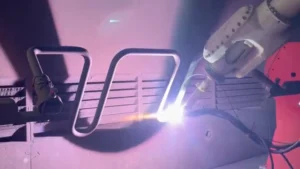table of contents
- Heading 1
- Heading 1
- Heading 1
share this
Around the world, companies are increasing their use of robots. According to the International Federation of Robotics (IFR), the global average for industrial robots per 10,000 manufacturing workers has grown from 66 in 2015 to 126 in 2021. Robotics is a rapidly advancing field that promises significant improvement in cost-savings and performance in the next decade. Robotic sandblasting is one such industry that has experienced a significant impact from robotics utilization.
Understanding Blasting Automation and Robotics
What Is Robotic Sandblasting?
Robotic Sandblasting, also known as robotic abrasive blasting, is a surface treatment process that sprays abrasive particles under high pressure against a surface. It leverages the abrasive nature of different blasting media to smooth, shape, or clean a surface. This is commonly used in the manufacturing industry for cleaning metal parts, removing rust and paint, etching glass, and creating textures on surfaces. However, almost all industries, for example, aerospace, maritime, automotive, etc. need blasting at certain points in time.
Advantages of Automated Blasting Systems
Improve Safety
Sandblasting has traditionally been done manually, which may be time-consuming, inconsistent, and dangerous for the individuals involved. Robotics has since made the process much more streamlined and efficient for many manufacturing companies. Robots could perform tasks with better efficiency and accuracy as compared to workers. One of the greatest applications of automated blasting systems is they can be used in hazardous environments. In the case of abrasive blasting, dangerous toxins, and particulate matter as a result of the procedure may lead to serious respiratory illnesses and even lung cancer in the long run. Robots could protect workers against hazardous environments by reducing their exposure and potential health issues arising from it.
Improve Precision
While manual sandblasting may be effective, cutting-edge robotic solutions provide greater accuracy and efficiency. Robotic arms are programmed to perform the sandblasting process according to the specific requirements set by the programmer for the particular workpiece. Precise control over the sandblasting parameters such as speed, angle, and intensity of the abrasive particles could all be fine-tuned to the requirements of the project.
Improve Quality
As industrial sandblasting robots can produce consistent and repeatable results, robot sandblasted surfaces tend to be of higher quality finishes. When considering manual sandblasting, variations in quality and faults are inherent because humans are not capable of doing the same activities repeatedly with the same consistency and accuracy. Furthermore, the use of robotics allows for precise control over the sandblasting parameters which lowers the risk of damaging the workpiece and guarantees uniformity every time.
Improve Productivity
Robotic systems could operate continuously without breaks for extended periods. This optimizes current sandblasting processes, leading to higher output and reduced lead times. Coupled with industrial robot programming automation software, whereby companies can program sandblasting robots via the scan and plan method, the efficiency of deployment and path planning in robotics improves exponentially. This further improves overall sandblasting setup and process productivity, generating higher outputs and resulting in a higher return on investment.
Applications of Automated Blasting Systems
Automated blasting systems are indispensable in numerous industries, providing significant enhancements in efficiency, precision, and safety.
Automotive Industry:
Automated blasting systems in the automotive industry are used for surface preparation tasks such as removing paint, rust, and other contaminants from metal parts. This ensures that surfaces are impeccably clean and smooth before painting or coating. This is crucial for achieving high-quality finishes and preventing future corrosion.
Additionally, this technology develops uniform textures on a component’s surface to meet aesthetic and functional standards.
Aerospace Industry:
In the aerospace industry, it is mostly used in MRO which stands for maintenance, repair, and overhaul of components. The use of automated blasting systems is even more critical here due to the stringent safety and performance requirements. Aerospace components, including engine parts and structural elements, must undergo meticulous surface preparation to remove oxides, contaminants, and old coatings.
Automated blasting systems ensure that these tasks are performed with unparalleled precision and reduce the risk of defects that affect the integrity of the components. Manual blasting would be impractical or damaging.
Manufacturing industry:
In the manufacturing industry, they are employed for a variety of applications, from cleaning molds and dies to preparing surfaces for welding or bonding. Automated systems can handle large volumes of workpieces with consistent quality. This significantly improves throughput and reduces downtime.
In industries such as metal fabrication, these systems are used to create specific surface finishes. This could be so whether for functional purposes, such as enhancing adhesion properties, or for aesthetic reasons.
Construction and Shipbuilding:
These are other sectors where automated blasting systems are gaining traction. In construction, these systems are used to prepare concrete surfaces, clean steel structures, and remove coatings from various materials. In shipbuilding, they play a vital role in maintaining hull integrity by removing marine growth and old paint, ensuring that ships remain seaworthy and efficient.
Choosing the Right Blasting Automation System
Selecting the appropriate blasting automation system is a critical decision. This can significantly impact your operational efficiency and product quality.
Type of surface preparation:
Different applications may necessitate varying levels of abrasiveness, precision, and coverage. For example, delicate aerospace components might require a system capable of fine-tuning parameters to avoid damage, while large industrial parts might benefit from a more robust system capable of handling high-volume throughput.
Specific requirements of the industry:
Each industry has unique demands regarding surface finish standards, material handling, and safety regulations. For instance, the automotive industry often requires systems that can achieve both high throughput and precise, uniform finishes.
Whereas, the aerospace industry demands systems capable of delivering exceptional precision and consistency to meet stringent safety standards. Therefore, selecting a system designed to cater to your specific needs is crucial.
Robotic System Capability:
Modern automated blasting systems come equipped with advanced features such as programmable robotic arms, real-time monitoring, and adaptive control systems. These features enable the system to adjust parameters dynamically for optimal performance across various tasks.
Additionally, the ease of integration with existing workflows and compatibility with different blasting media should be considered. To maximize the system’s versatility and ROI, this is crucial.
Scalability and Flexibility:
As your operational needs evolve, the ability to scale up the blasting system or reconfigure it for different tasks can provide significant long-term benefits.
This might involve modular components, software upgrades, or the ability to handle multiple types of media without extensive reconfiguration.
Cost:
While the initial investment in an automated blasting system can be substantial, the long-term savings in labor, improved productivity, and reduced material waste can make it a worthwhile investment. Conducting a thorough cost-benefit analysis, considering both direct and indirect savings, will help justify the expenditure.
Choosing a Reliable Partner:
A partner that offers comprehensive support services can provide a smooth implementation process and ongoing assistance to address any operational challenges. This includes training your staff to operate and maintain the system effectively. All these are vital for maximizing its benefits and longevity.
By carefully considering these factors, you can select a blasting automation system that not only meets your immediate needs but also supports your long-term operational goals.
Conclusion
The use of robotics has revolutionized the sandblasting industry. As the industry evolves, there is a greater need to optimize cost savings and invest in opportunities for greater productivity, precision, and safety.
Blasting Automation and Robotics With Augmentus
Optimise sandblasting technologies with our partner robot brands and our proprietary scan and plan technology. At Augmentus, robot motion planning is made easier through a graphical interface on an iPad. This brings down robot programming halt time by more than 90%.
By choosing the right blasting automation system, you can significantly boost your ROI and optimize your sandblasting processes. Schedule a demo with our automation expert today to enhance your surface preparation!
FAQs
How do automated blasting systems improve surface preparation?
Automated blasting systems improve surface preparation by providing consistent and precise control over the blasting process, reducing human error, and enhancing the quality of the finished surface.
What is the difference between sandblasting and abrasive blasting?
Sandblasting specifically uses sand as the abrasive media, while abrasive blasting can utilize a variety of media, such as glass beads, steel grit, or aluminum oxide, depending on the desired finish and material being treated.
How does a sandblasting robot work?
A sandblasting robot works by using programmed robotic arms to direct abrasive particles at high speed and pressure onto a surface. The parameters such as angle, speed, and intensity are controlled to achieve the desired surface finish.
What are the benefits of using robotic abrasive blasting systems?
The benefits of using robotic abrasive blasting systems include improved safety, precision, quality, and productivity. These systems can operate in hazardous environments, provide consistent results, and run continuously, increasing overall efficiency.
Which industries benefit most from automated blasting systems?
Industries such as automotive, aerospace, manufacturing, and construction benefit most from automated blasting systems due to the high demand for precise and consistent surface preparation.




